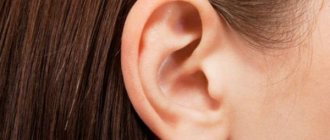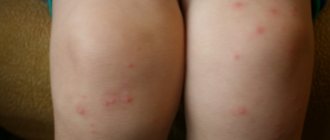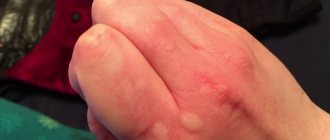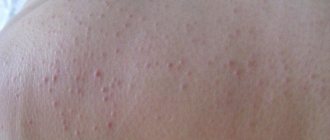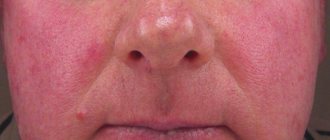Sometimes both women and men experience rashes on the thighs. It's not always something critical, sometimes it's just acne.
However, it is important to pay close attention to such a problem, because it is quite possible that this is a symptom of a dangerous disease that will be easier to defeat at the initial stage.
Causes of skin allergies in adults
There are a large number of allergens that can trigger an unwanted skin reaction. This, in turn, is the cause of the development of allergic dermatosis.
Many experts believe that the number of allergy sufferers has begun to increase rapidly due to unfavorable changes in the environmental situation and due to the consumption of genetically modified products.
In addition, various cosmetics contain haptens, which can also trigger skin allergies.
Skin rashes can be caused by the following allergens:
- Household dust.
- Chemistry.
- Cosmetics.
- Clothes made from synthetic fabrics.
- Medications.
- Food.
- Personal hygiene products.
- Pet fur.
- Pollen.
How to prevent a rash on your thighs
To prevent problems from arising, it is important to maintain a healthy lifestyle. More specifically, it is important to ensure safe sex. It is better to streamline sexual relations. Sexual contact should ideally be with only one partner.
However, even in this case there is some risk, because some people carry a lot of viruses and other sexually transmitted diseases. At the same time, they themselves were not infected with them in this way and do not suspect their existence due to their strong immunity. For example, such diseases include the human papilloma virus.
It is also important to maintain good hygiene procedures at all times. You should wash at least once a day, but not more often. If contact with water is too long or too frequent, a reaction may occur on the skin in the form of a rash.
You should also carefully select detergents and never wash with anything. If you follow these simple rules, a rash on your thighs is unlikely to occur.
The mechanism of skin allergies
The main factor in the manifestation of allergic dermatosis is considered to be an allergen - a substance of molecular structure that is of protein origin.
It happens that allergens can be various elements that do not provoke an immune response when they penetrate the blood. Particles that are carried by antigenic determinants are called haptens. These elements can bind to tissue proteins. Haptens are found in medications and other chemicals.
If an allergen or irritant enters the human body, sensitization begins to develop, which subsequently leads to excessive sensitivity of histamine receptors. This action is explained by the formation of antibodies or the synthesis of sensitized leukocytes.
An allergic rash on the skin of an adult forms at the stage of pathophysiological development of the disease. At this time, mediators of the pathological process are able to affect normal skin cells, provoking an inflammatory process.
Itching
In most cases, skin allergies can be accompanied by itching of varying intensity. The main causes of itching are external and internal allergens.
The body begins to perceive such allergens as dangerous, which results in an allergic reaction in the form of itching. There are several main allergic skin diseases that can be accompanied by itching. These diseases are described below.
Here you will find in more detail the answer to the question of what to do when a spot on the skin itches due to an allergy.
Types of rashes on the buttocks in women
Contrary to popular belief, rashes are not always pimples. Despite the fact that pustules, or small pimples with purulent contents, are the most common type of rash on the female body, there are other types of this pathology.
So, on the “fifth point” in women you can find the following types of rash:
- spots;
- vesicles, or watery blisters;
- pustules;
- scales;
- nodules.
The nature and appearance, as well as the location of the rashes, are always explained by the cause that provoked them.
Causes of a rash on the buttocks in an adult
If a rash on the buttocks and thighs of an adult does not go away for a long time, and no treatment methods with creams and ointments help, most likely the cause lies in diseases of the internal organs and systems.
In particular, the following ailments can provoke the appearance of rashes on the “fifth point”:
- The cause of acne on the buttocks is usually various liver disorders. This applies not only to severe lesions of this organ, such as cirrhosis, but also to mild disorders of its function caused by poor diet or abuse of alcoholic beverages;
- allergic reactions. Most often, this pathology can be encountered as a result of excessive consumption of exotic or citrus fruits, as well as long-term use of certain medications. Allergic dermatitis most often appears as fairly large spots or small papules;
- areas of red purulent rash on the buttocks may appear against the background of diabetes mellitus and other endocrine diseases;
- fixed toxicoderma - a chronic disease of an allergic nature, also often causes spots on the butt;
- psoriasis that has spread throughout the body can cause rashes in the form of scales or spots, as well as cracks in the butt area. With this disease, the affected skin itches very much, but in most cases does not cause severe pain;
- if the rash on the buttocks hurts and itches, most likely it is caused by a herpetic lesion of this part of the body;
- Finally, in rare cases, a similar problem can be caused by syphilis and other sexually transmitted diseases. As a rule, with such ailments, the rash can be found not only on the butt, but also in the groin area.
In addition, in some cases, a rash on the buttocks and between them in adults appears as a result of exposure to certain external factors. Under such circumstances, it goes away within a few days after the cause is eliminated and does not cause much concern.
This may be related:
- with prolonged exposure to too high or low ambient temperatures;
- with constant sitting on the “fifth point”;
- with insufficient body hygiene. A similar problem occurs when dead skin cells are not promptly removed from the human body;
- with wearing underwear made of low-quality synthetic materials, which strongly rubs against the delicate skin of the buttocks.
Allergic rashes in adults
It is also worth noting that allergies can simply be expressed by rashes on the skin without the presence of itching. However, an allergic rash may look different, depending on the disease itself.
Features of an allergic rash:
- The rashes do not have a clear shape.
- The spots have blurred edges.
- The color of the spots can range from pink to dark red.
- The rash may be accompanied by mild swelling.
- Sometimes peeling appears.
- The rashes can be localized throughout the body, depending on the type of allergy.
- Rashes can take various forms: spots, nodules, blisters, blisters.
Types of allergies
The appearance and characteristics of skin rashes depend on the type of allergic dermatosis. The rash can appear either on a separate area of the body, for example, an allergy on the legs, or be localized throughout the body.
That is why in medicine there are several main types of allergic reactions:
- Atopic dermatitis.
- Contact dermatitis.
- Hives.
- Eczema.
- Toxidermy.
- Neurodermatitis.
- Quincke's edema.
- Lyell's syndrome.
- Steven-Johnson syndrome.
Atopic dermatitis
Atopic dermatitis is an individual skin disease that is not transmitted by contact. Atopic dermatitis is prone to complications and relapses, so this disease must be constantly monitored, like any other type of allergy.
Symptoms of atopic dermatitis:
- Skin itching.
- Dry skin.
- Skin irritation.
Atopic dermatitis can cause discomfort, psychological instability, loss of performance, and bacterial infection of the skin.
Atopic dermatitis can be triggered by the following factors:
- Dust.
- Insect bites.
- Pet fur.
- Pet food.
- Medications.
- Unfavorable environmental conditions.
- Food.
Photo of atopic dermatitis
Contact dermatitis
Contact dermatitis is a type of allergic inflammation of the skin that occurs after skin contact with an external allergen or irritant. If a person has hypersensitivity to an allergen, contact dermatitis develops quickly, however, there are cases when this allergic disease can develop over several weeks.
Symptoms of contact dermatitis:
- Redness of the skin.
- Swelling of the area of skin that came into contact with the irritant.
- Bubble formation.
- Rashes.
- Formation of erosion.
- Itching.
Contact dermatitis can occur when the skin is exposed to the following factors:
- Food.
- Cosmetical tools.
- Chemicals used in everyday life.
- Metals.
- Medicines.
- Clothes made from synthetic fabrics.
Photo of contact dermatitis
Hives
Urticaria is a very common skin disease that involves the formation of local swelling and blisters, accompanied by severe itching.
Symptoms of urticaria appear only after contact with an external or internal irritant and are as follows:
- Formation of blisters, the size of which can be 5 mm.
- The color of the blisters is pink or red.
- Cardiopalmus.
- General weakness.
- Swelling of the skin.
- Sometimes there is a burning sensation.
- Itching.
- Dizziness.
After the blisters disappear, no marks remain on the body. As for the causes of urticaria, only 5% of them are allergic.
The main ones should be highlighted:
- Presence of a viral infection.
- Insect bite.
- Blood transfusion.
- Stress.
- Cold.
- Sun rays.
- Tight clothes, woolen items.
Photo of hives
To visualize this skin disease, a photo of urticaria is presented.
Causes in adults
In adults, a rash in the form of small red dots most often occurs on the legs and thighs. Such rashes may be caused by:
- Allergic reaction to synthetic clothing fabric.
- Personal hygiene products used.
- Contagious skin pathologies such as scabies or mycoses.
- Violations of hygiene rules.
- Insect bites.
- Damage to the skin with subsequent development of the inflammatory process.
A rash on the legs also occurs with psoriasis, ichthyosis, eczema, and accompanies some serious diseases of the internal organs.
On hands
Rashes on the arms and hands are less common than on the body and lower extremities. The appearance of a rash on the hands is usually caused by an allergic reaction. This could be contact dermatitis in response to using the wrong soap, hand cream or laundry detergent.
The appearance of reddish itchy blisters indicates the development of herpes zoster or herpetic skin lesions.
Rashes on the hands can also appear after sunburn or colds.
On the lower extremities in the form of red dots
The rash on the legs can be of different shapes and colors, accompanied by itching, unpleasant painful sensations, increased body temperature and general malaise.
If pathological rashes appear, especially those that appear suddenly and are also accompanied by deterioration in health, it is important to consult a doctor as soon as possible for examination and selection of effective treatment.
On the hips
A rash on the thighs causes significant discomfort, especially if it is located on the inner side. Such rashes lead to pain when wearing clothes, while walking or doing physical activity.
The causes of rashes on the thighs include:
- Skin irritation caused by wearing tight underwear, tights, trousers.
- Contact dermatitis caused by unsuitable personal hygiene products.
- Damage to the skin when shaving, after waxing.
- Ingrown hairs.
- Diaper rash on the inner thighs due to excess weight, excessive sweating, dyshidrosis.
- The presence of viral diseases such as molluscum contagiosum, herpes simplex, herpes zoster.
- Pustular pathologies (pyoderma, furunculosis, carbuncles).
- Chronic dermatoses (psoriasis, lichen planus, eczema).
- Allergic manifestations (dermatitis, urticaria).
Rashes and pimples of various types on the thighs can appear due to pathologies of the gastrointestinal tract, changes in hormonal levels, nutritional disorders, and hypovitaminosis.
Compared to children, a rash on the thighs in adults develops much less frequently against the background of infectious diseases - chickenpox, scarlet fever, measles or rubella.
An alarming symptom is a star-shaped hemorrhagic rash that appears on the skin of the lower back, buttocks, and thighs in a matter of hours and is accompanied by high fever. This is one of the signs of a terrible pathology - meningococcemia, which requires immediate hospitalization in an infectious diseases hospital.
On the shin
Very often, rashes of various types affect the skin on the knees. Most of them are not dangerous, but some may be a symptom of a dangerous disease and require special attention. For any rash, even a minor one, it is better to consult a dermatologist.
A rash appears on the calves of adults when:
- Sunburn, chemical burns, pigmentation.
- Allergies to cosmetics, food, clothing fabric.
- Pruritic dermatitis, psoriasis, ichthyosis, necrobiosis lipoidica.
- Lupus erythematosus, scleroderma, hemorrhagic vasculitis.
In older people, a rash on the legs occurs against the background of varicose veins, atherosclerotic vascular lesions of the lower extremities, diabetes mellitus, myocarditis, dysfunction of the liver and pancreas.
Rashes on the legs occur with thrombocytopenia, leukemia, cancer pathologies and HIV/AIDS.
On the foot
Many people experience various rashes on their feet throughout their lives. The most common causes of red dots and spots are:
- Scabies. The elements of the rash are reddish dots arranged in pairs, between which scabies can be found. A distinctive sign of scabies is increased itching and burning of the skin at night and after taking a hot shower.
- Foot skin fungus. Accompanied by the appearance of a reddish or pink rash, peeling, unpleasant odor and increased sweating. Another characteristic sign of mycosis is a change in the color and thickness of the nails, and an increase in their fragility.
- Contact dermatitis. Tight shoes, synthetic socks, neglect of personal hygiene rules - all this can cause the appearance of a red rash and irritation on the skin of the feet.
If it itches
An itchy rash on the legs is most often the presence of allergic pathologies. Dermatitis and urticaria can appear either immediately or several days after contact with the allergen. With these ailments, in addition to the rash, a red spot of irregular shape, dryness, and peeling may appear on the skin.
Severe itching is characteristic of herpetic rashes and chicken pox. Moreover, its intensity with chickenpox in adults is stronger than in children, and they tolerate the disease itself more severely.
With herpes simplex, the rashes are represented by small blisters, arranged in groups, and filled with clear inflammatory fluid. The skin itches due to scabies, fungal infections of smooth skin, and bites of various insects.
Eczema
Eczema is commonly called a dermatological disease that affects the upper layers of the skin. This skin pathology is allergic in nature. Eczema appears literally anywhere, but is mainly localized on the hands and face. This allergic skin disease can develop in anyone, regardless of age and gender.
Main symptoms of eczema:
- Acute inflammation.
- Numerous rashes.
- The appearance of small point erosions after opening.
- Serous fluid in formations.
- Severe itching.
It is worth paying attention that eczema can be complicated by a secondary infection.
Causes of eczema:
- Endocrine system disorder.
- Stress and depressive disorders.
- Metabolic disorders.
- Food allergic reaction.
- Household dust.
- Pollen.
- Allergic reaction to household chemicals.
- Using cosmetics that provoke the development of allergies.
Photo of eczema
Symptoms and signs
Redness on the inner thigh occurs due to various diseases.
Allergic reactions
Contact dermatitis is a fairly common type of allergy. Appears as:
- swelling;
- redness;
- blisters and blisters.
Irritation may be caused by using:
- synthetic underwear;
- woolen items;
- gaskets;
- bed linen;
- washing powder.
Symptoms of the disease are severe itching and burning in the affected area.
Eczema is a disease of the outer layer of the epidermis of an allergic nature. Bright red spots appear on the skin, which are accompanied by swelling and the formation of blisters. After opening, wet areas remain; when dry, they become covered with scales. There is pain and a burning sensation.
Psoriasis is a chronic dermatosis in which, in the initial stages, small spots appear on the inner surface of the thigh. Their size may increase and peeling occurs. The disease is of hereditary or psychosomatic origin. It worsens after drinking alcohol, severe stress and overwork.
Fungal diseases
Ringworm is a common type of mycosis. It affects people of all ages. The cause may be hormonal imbalances or the chemical composition of sweat. Dark spots appear on the inner thighs of women. May develop after childbirth. Accompanied by peeling and inflammatory processes.
Joubert's lichen, or pityriasis rosea
Pityriasis rosea is a seasonal disease, most often occurring in spring and autumn. Pink spots appear that do not itch or peel. The cause is considered to be decreased immunity or hormonal imbalances.
Rubromycosis is a fairly common disease that affects the inguinal-femoral part and buttocks. A red spot, similar to a burn, the size of a saucer appears on the thigh. The lesions have boundaries surrounded by bubbles and scales with a rough surface. There is a feeling of weeping, burning, pain when rubbing.
You can become infected in public places:
- in the bath;
- sauna;
- in a swimming pool.
Athlete's foot is a common mycosis in men and women. If a large red spot appears on the inside of the thigh and is rough to the touch, this is a characteristic symptom of the disease.
At first, a small spot is observed, which gradually increases in size. Peeling occurs and crusts form on the surface. Itching and pain are felt when rubbing the skin. Usually worsens in summer.
Factors influencing infection with inguinal fungus:
- stress;
- obesity;
- heavy sweating;
- uncomfortable clothes;
- hormonal disorders;
- weak immunity.
Trichophytosis is a fungal infection of the skin, another name is ringworm. Inflammation, peeling, and abscesses appear. The lesions are bluish in color with gray scales. The wounds may crack. Infection occurs from sick animals, through household items.
Erythrasma - usually develops under folds of skin, in the groin of obese people. Brown and red spots form. The affected area has a round shape.
Candidiasis is a fungal disease caused by the Candida fungus. Under its influence, damage to the skin and mucous membranes occurs. Active reproduction occurs in warm and humid environments.
- Lesions appear in the form of red spots.
- Minor swelling occurs.
- Itching appears.
The formations burst, leaving a wet surface with a white coating. The causes of the development of cutaneous candidiasis are internal pathologies:
- metabolic disease;
- diabetes;
- avitaminosis;
- chronic infections;
- disturbance of intestinal microflora;
- obesity.
Infections
Folliculitis
Folliculitis is a superficial form of pyoderma, characterized by inflammation of the hair follicles due to staphylococcus. Causes:
- skin injury;
- epilation;
- insufficient hygiene;
- diabetes;
- tuberculosis;
- endocrine diseases;
- oncology;
- hypovitaminosis.
If treatment is not carried out, the formation of a boil, carbuncle, or abscess is possible.
Diaper rash can occur:
- in obese people prone to excessive sweating;
- when using tight synthetic clothing;
- if personal hygiene is not observed.
Symptoms include redness and skin irritation. A secondary infection may occur.
Neurodermatitis
Neurodermatitis is a skin disease characterized by tissue inflammation. In most cases, neurodermatitis begins to develop against the background of an allergic reaction. However, in addition to this, there are a number of other factors that can provoke the development of this disease.
Symptoms of the development of neurodermatitis:
- Itching that gets worse at night.
- Rashes in the form of red spots.
- Formation of plaques that can merge with each other.
- Formation of bubbles with liquid contents.
- Swelling.
The main causes of neurodermatitis:
- General weakening of the immune system.
- Intoxication of the body.
- Inflammation of the skin.
- Metabolic dysfunctions.
- Presence of gastrointestinal diseases.
- Heredity.
- Physical exhaustion.
- Poor nutrition.
- Wrong daily routine.
- Stress, depression.
Photo of neurodermatitis
Possible diseases
A rash on the thighs is a symptom of various diseases. It is typical for hemorrhagic vasculitis, measles, chickenpox, diabetes mellitus, disorders of the gastrointestinal tract, and pathologies of the genitourinary system. But most often it is caused by:
- Scabies is a contagious skin disease. It is caused by a microscopic mite, transmitted through prolonged tactile contact (more than 30 minutes) from person to person. The incubation period of the disease lasts up to 4 weeks. Only after this time has passed, the patient notices that the rash on the thigh itches, especially in the evening. You can see whitish lines on the surface of the skin - this is how ticks gnaw their passages. Regular itching leads to scratching of the skin, the appearance of red crusts and subsequent bacterial infection.
- Mycoses are diseases caused by parasitic fungi. They can become infected when visiting public places or contacting a sick person or pet. There are mycoses of the legs, localized mainly in the area of the lower extremities (usually they begin with the feet and nails), as well as mycoses of smooth skin. The affected area becomes inflamed, swollen and itchy; Sometimes peeling and the appearance of bubbles on the surface are observed.
- Furunculosis is an inflammation of the hair follicle with the formation of pus, provoked by staphylococcal infections. With this disease, the spots on the skin will be convex, and inside them there will be a greenish or yellowish liquid. This rash on the thigh does not itch, but hurts and swells.
- Genital herpes is a disease transmitted through sexual contact with an infected person or from a sick mother to a child during pregnancy. However, the carrier of the disease may have no symptoms. The incubation period lasts on average from 1 to 26 days. Clinical manifestations are fever, general malaise, headache. The rashes look like small blisters filled with clear liquid. After a few days they open, turning into red sores.
To determine the cause of the rash, you need to consult a dermatologist as soon as possible. Self-medication and the use of folk recipes without an accurate diagnosis will be ineffective.
Quincke's edema
Quincke's edema is local swelling of the mucous and fatty tissue. This disease occurs suddenly and is characterized by its rapid development.
Quincke's edema most often develops in young people, mainly women. Swelling occurs on the principle of a common allergy. In most cases, Quincke's edema is combined with urticaria, expressed in acute form. Most often, this disease is localized on the face.
The main symptoms of Quincke's edema:
- Swelling of the airways.
- Hoarseness.
- Difficulty breathing.
- Cough.
- Swelling of the lips, eyelids, cheeks.
- Swelling of the oral mucosa.
- Swelling of the genitourinary organs.
- Acute cystitis.
Causes of Quincke's edema:
- Allergic reaction to food.
- Dyes and artificial additives in food.
- Pollen.
- Pet fur.
- Feathers.
- Insect bites.
- Regular dust.
Photo of Quincke's edema
To visually assess the extent of the allergic reaction, look at the photo of Quincke's edema.
Lyell's syndrome
Lyell's syndrome is the most severe form of allergic reaction to medications. This disease is characterized by severe dehydration, toxic damage to internal organs and the development of an infectious process. Lyell's syndrome is very dangerous and can be fatal if you do not seek help in a timely manner.
Symptoms of the development of Lyell's syndrome are very similar in appearance to 2nd degree burns, as they are characterized by:
- The appearance of wounds on the skin.
- Formation of cracks in the skin.
- Bubble formation.
Causes of Lyell's syndrome:
- Antibacterial agents.
- Anticonvulsant drugs.
- Anti-inflammatory drugs.
- Painkillers.
- Drugs to combat tuberculosis.
- Use of dietary supplements and drugs that enhance immunity.
Photo of Lyell's syndrome
Steven-Johnson syndrome
Steven-Johnson syndrome is a form of exudative erythema multiforme, which is characterized by inflammation of the mucous membranes and skin.
This disease has a very severe course. Most often, Steven-Johnson syndrome affects people over 40 years of age, however, cases of the disease have also been recorded in young children. In the first stages, the disease affects the respiratory tract.
Symptoms of Steven-Johnson syndrome:
- Fever.
- General weakness.
- Cough.
- Headache.
- Joint and muscle pain.
- Vomit.
- Diarrhea.
- Rashes on the skin.
- Swelling of formations.
- The rash is red.
- Itching.
- Burning.
- Skin lesions bleed.
Causes of Steven-Johnson syndrome:
- Existing infectious diseases.
- Allergic reaction to medications.
- Malignant diseases (cancer).
Photo of Steven-Johnson syndrome
Are there red spots with candidiasis?
One of the fungal diseases, including skin reactions in the form of spots, is candidiasis. The causative agent of this infection is the yeast-like fungus Candida, which resides in small quantities on the surface of the skin of any person. Many microorganisms, along with it, make up the natural microflora of the body, however, under certain circumstances, the population of a particular species can increase sharply. This is the mechanism for the development of infectious diseases. If there is an increase in the number of Candida fungi, a person develops candidiasis.
Candidiasis or, as it is commonly called, thrush affects the surface of the skin and mucous membranes. Most often observed in the genital area, in the oral cavity, less often in the throat and on the mucous membrane of internal organs, but can form in any part of the body. The Candida fungus, like the vast majority of other pathogenic fungi, prefers a warm, moist environment.
In order for an outbreak of activity of this type of microorganism to occur and red spots to form on the inside of the thighs, conditions are necessary that are conducive to this. When it comes to thrush in the genital area, the predominantly sexual route of transmission of the pathogen is considered. Cutaneous candidiasis in the vast majority of cases is provoked by internal causes, for example:
- Imbalance of intestinal microflora;
- Metabolic disease;
- Diabetes;
- Immunodeficiencies;
- Dysbacteriosis;
- Chronic infections;
- Avitaminosis;
- Obesity and others;
Under the influence of favorable factors, the fungus begins to actively multiply, forming lesions in the form of red spots, including on the inside of the thigh.
Types of allergic rashes
In most cases, allergic rashes have several types, which are characterized by an inflammatory process.
Types of primary rash that are a symptom of the development of a skin disease:
- Erythema is redness of the skin that occurs due to excessive blood supply to the vessels.
- Papule is a flat, dense formation.
- Vesicle is a formation with clear or cloudy contents.
- A pimple is an inflammation of the follicle with purulent contents.
Treatment
Treatment of an allergic rash may involve one or more methods, which include the following:
- Allergen elimination, which involves eliminating exposure to the allergen. If the allergen is a food product, then a specialist will prepare a special diet for the patient. However, this method will not be relevant if the allergen is dust or pollen.
- Immunotherapy involves injecting microdoses of the allergen. There are also special drops that are dripped under the tongue. This method is designed for long-term treatment.
- Medications in the form of ointments and medications for oral administration.
It is worth paying attention to the fact that many antihistamines and topical medications are contraindicated in pregnant women. In this case, the attending physician must select an alternative treatment.
Antihistamines
For allergic rashes, a specialist may prescribe the following antihistamines:
- Gistan.
- Allertek.
- Fexadine.
- Diphenhydramine.
- Astemizole.
All of the listed drugs should be prescribed by a doctor only after conducting a special examination and passing all the necessary tests. Otherwise, it may lead to a more severe allergic reaction to the medications.
Ointments
Antihistamines are often prescribed in combination with ointments or creams. Local treatments are divided into two types: hormonal and non-hormonal.
Hormonal drugs for local therapy:
- Prednisolone.
- Afloderm.
- Momat.
Non-hormonal drugs for local therapy:
- Fenistil-gel.
- Levomekol.
- Panthenol.
- Solcoseryl.
Syphilis
With this disease, a rash sometimes appears on the thighs and groin area. Most often it is a rash on the inner thighs. In the first period of the disease these are small ulcers. In the second period - small red spots. The problem is that such a rash on the thigh does not itch, does not hurt, and does not cause any noticeable discomfort. But the earlier syphilis is detected, the lower the risk to life.
Only diagnosis and treatment using academic methods will bring results. You will need a whole range of drugs against the disease, individual for a particular person, taking into account his tolerance or intolerance to the components.
The doctor will also prescribe an ointment for topical use against the rash using the same principle. Treatment sometimes takes months.
